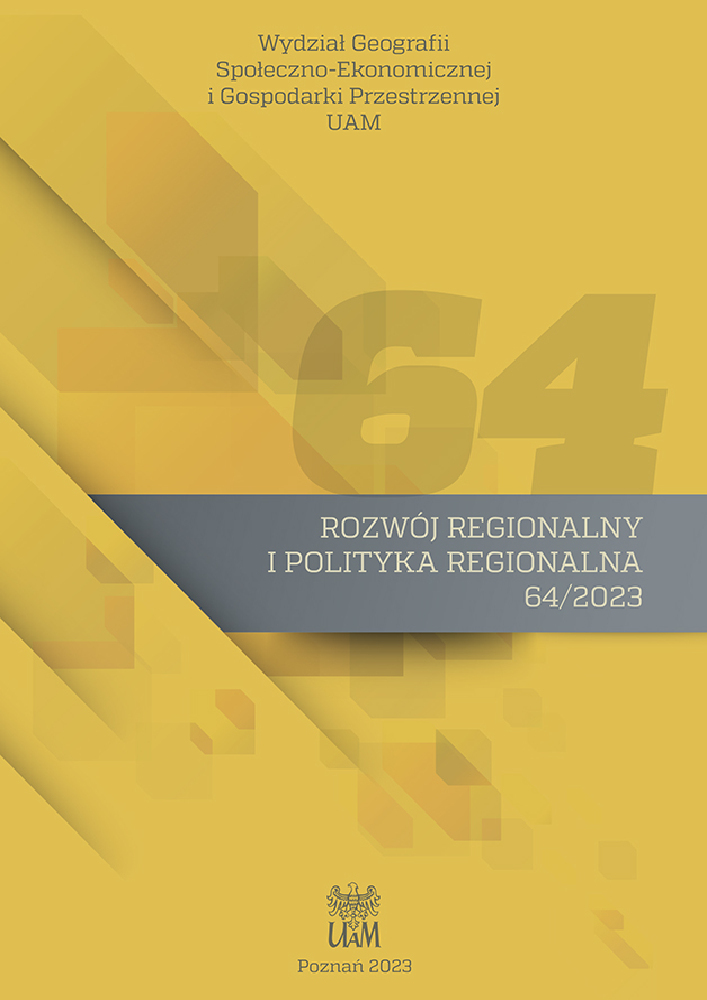Abstrakt
W literaturze przedmiotu pojawia się szereg pojęć, które odnoszą się do szeroko pojętych struktur przyrodniczych. Zachodzi pytanie, czy transponowanie tych pojęć do dokumentów planistyczno-strategicznych sprzyja integracji i spójności planowania przestrzennego oraz ciągłości krajobrazowej i zwartości struktury przyrodniczej na danym terenie. Celem opracowania jest sformułowanie koncepcji zintegrowania struktury ekologicznej krajobrazu gminy Września. Aby zrealizować przyjęty cel, przeprowadzono inwentaryzację struktur przyrodniczych oraz elementów infrastruktury technicznej. Ponadto dokonano weryfikacji lokalnych i ponadlokalnych zapisów planistycznych oraz strategicznych w kontekście struktur przyrodniczych dla gminy Września. W tym celu określono i obliczono wskaźnik integracji pionowej oraz poziomej zapisów planistyczno- -strategicznych. Badania wykazały przeciętny poziom integracji dokumentów planistycznych gminy. Najwyższy wskaźnik zintegrowania dokumentów odnotowano na szczeblu lokalnym. W układzie przyrodniczym gminy odnotowano zróżnicowane formy zieleni oraz luki i bariery w ciągłości jego funkcjonowania.
Bibliografia
Ahern J. 2010. Planning and design for sustainable and resilient cities: theories, strategies and best practices for green infrastructure. [W:] V. Novotny, J. Ahern, P. Brown (red.), Watercentric sustainable communities. Planning retrofitting and building the next urban environment. John Willey &Sons, s. 135–176. DOI: https://doi.org/10.1002/9780470949962.ch3
Bauduceau N., Berry P., Cecchi C., Elmqvist T., Fernandez M., Hartig T., Krull W. i in. 2015. Towards an EU Research and Innovation Policy Agenda for Nature-based Solutions & Re-naturing Cities: Final Report of the Horizon 2020 Expert Group on ‘Nature-based Solutions and Re-naturing Cities’. Publications Office of the European Union, Bruxelles.
Benedict M.A., McMahon E.T. 2006. Green infrastructure: linking landscapes and communities. ISLAND PRESS, Washington.
Chmielewski T.J., Chmielewski S. 2015. Podstawowe przyrodnicze jednostki przestrzenne, a spójność i stabilność ekologiczna systemów krajobrazowych. Problemy Ekologii Krajobrazu, 40: 145–160.
CICES, Common International Classification of Ecosystem Services – version 4.3, update January 2013 (Wspólna Międzynarodowa Klasyfikacja Usług Ekosystemowych – CICES w. 4.3, aktualizacja styczeń 2013 r.).
COM/2013/0249 – Communication From The Commission To The European Parliament, The Council, The European Economic And Social Committee And The Committee Of The Regions Green Infrastructure (GI) – Enhancing Europe’s Natural Capital (https://eur-lex.europa.eu/legal-content/PL/TXT/?uri=celex%3A52013DC0249 ; dostęp: 20.11.2022).
COM/2006/0216 – Communication from the Commission – Halting the loss of biodiversity by 2010 – and beyond – Sustaining ecosystem services for human well-being (https://eur-lex.europa.eu/legal-content/en/TXT/?uri=CELEX:52006DC0216 ; dostęp: 20.11.2022).
Costanza R., d’Arge R., de Groot R., Farber S., Grasso M., Hannon B., Limburg K., Naeem S., O’Neill R.V., Paruelo J., Raskin R.G., Sutton P., van den Belt M. 1997. The value of the world’s ecosystem services and natural capital. Nature, 387(6630): 253–260. DOI: https://doi.org/10.1038/387253a0
Dobbs C., Kendal D., Nitschke C.R. 2014. Multiple ecosystem services of the urban forest establishing their connections with landscape structure and sociodemographics. Ecological Indicators, 43: 44–55. DOI: https://doi.org/10.1016/j.ecolind.2014.02.007
Faivre N., Fritz M., Freitas T., Boissezon B., Vandewoestijne S. 2017. Nature-Based Solutions in the EU: Innovating with nature to address social, economic and environmental challenges. Environmental Research, 159: 509–518. DOI: https://doi.org/10.1016/j.envres.2017.08.032
Forman R.T.T. 1995. Land Mosaics. The ecology of landscape of regions. Cambridge University Press, s. 632. DOI: https://doi.org/10.1017/9781107050327
Forman R.T.T., Godron M. 1986. Landscape ecology. J. Wiley & Sons, s. 619.
Giedych R., Szulczewska B., Doygun H., Halonova L., Dobson S., Nurlu E. 2011. Green infrastructure policy as a tool of urban areas sustainable development, EURA 2011 Conference Cities without limits – on line papers (http://conventionbureauet.wufoo.com/reports/cities-without-limits-papers/http/true ; dostęp 27.11. 2022).
https://geoserwis.gdos.gov.pl/mapy (dostęp: 23.09.2022).
https://www.geoportal.gov.pl (dostęp: 2.09.2022).
https://wrzesnia.e-mapa.net/ (dostęp: 12.11.2022).
https://www.poznan.pzd.pl/ogrody.php?body=article&name=wrzesnia&lang=pl (dostęp: 29.10.2022).
John H., Marrs C., Neubert M. 2019. Podręcznik zielonej infrastruktury – tło koncepcyjne i teoretyczne, terminy i definicje, wersja skrócona w języku polskim. Projekt Interreg Central Europe MaGICLandscapes. Drezno (https://www.interreg-central.eu/Content.Node/MaGICLandscapes-Podrecznik-Zieloney-Infrastruktury.pdf ; dostęp: 20.11.2022).
Konijnendijk van den Bosch C. 2022. Evidence-based guidelines for greener, healthier, more resilient neighbourhoods: Introducing the 3-30-300 rule. Journal of Forestry Research. DOI: https://doi.org/10.1007/s11676-022-01523-z
Kowalski P. 2010. Zielona infrastruktura w miejskiej przestrzeni publicznej. Czasopismo Techniczne, 2-A, 5: 247–253.
Mitchell M.G.E., Suarez-Castro A.F., Martinez-Harms M., Maron M., McAlpine C., Gaston K.J., Johansen K., Rhodes J.R. 2015. Reframing landscape fragmentation’s effects on ecosystem services. Trends in Ecology and Evolution, 30, 4: 190–198. DOI: https://doi.org/10.1016/j.tree.2015.01.011
Oględzka E. 2010. Prawne aspekty planowania terenów zieleni w miastach. Studia Miejskie, 2: 267–283.
Pietrzak M. 1998. Syntezy krajobrazowe – założenia, problemy, zastosowania. Bogucki Wydawnictwo Naukowe, Poznań, s. 168.
Raszeja E., Szczepańska M., Gałecka-Drozda A., de Mezer E., Wilkaniec A. 2022. Ochrona i kształtowanie krajobrazu kulturowego w zintegrowanym planowaniu rozwoju. Bogucki Wydawnictwo Naukowe, Poznań.
Raymond C.M., Berry P., Breil M., Nita M.R., Kabisch N., de Bel M., Enzi V. i in. 2017. An Impact Evaluation Framework to Support Planning and Evaluation of Nature-based Solutions Projects. Report prepared by the EKLIPSE Expert Working Group on Nature-based Solutions to Promote Climate Resilience in Urban Areas. Centre for Ecology & Hydrology, Wallingford, United Kingdom.
Richling A., Solon J. 1998. Ekologia krajobrazu. Wyd. Nauk. PWN, Warszawa, s. 320.
Sylwester A. 2009. Green Infrastructure supporting connectivity, maintaining sustainability. European Commision, DG Environment (http://green-infrastructure-europeorg/download/Discussion%20 Paper%20Green%20Infrastructure%20Aleksandra%20Sylwester.pdf ; dostęp: 20.06.2011).
Szczepańska M. 2021. Zieleń na terenach wiejskich i zurbanizowanych. [W:] E. Kalbarczyk (red.), Przyrodnicze podstawy zintegrowanego planowania rozwoju. Bogucki Wydawnictwo Naukowe, Poznań.
Szulczewska B. 2018. Zielona infrastruktura – czy koniec historii? Studia Komitetu Przestrzennego Zagospodarowania Kraju PAN, 189.
Szulczewska B., Giedych R., Legutko-Kobus P., Nowak M.J. 2022. Zarządzanie zieloną infrastrukturą w mieście w kontekście dostępnych narzędzi prawnych i zarządzania rozwojem. Samorząd Terytorialny, 1–2: 26–43.
UNEP-5 2022. United Nations Environment Assembly of the United Nations Environment Programme, Fifth session, adopted 2022. Nature-based solutions for supporting sustainable development (https://wedocs.unep.org/handle/20.500.11822/39752;jsessionid=35872F8EFEFA98D61CBD16406507B0DD ; dostęp: 20.11.2022).
Zwierzchowska I. 2021. Podstawy kształtowania i ochrony środowiska przyrodniczego w skali krajobrazu. [W:] E. Kalbarczyk (red.), Przyrodnicze podstawy zintegrowanego planowania rozwoju. Bogucki Wydawnictwo Naukowe, Poznań.
Zwierzchowska I., Mizgajski A. 2019. Potencjał zielonej infrastruktury w dużych polskich miastach do świadczenia usług ekosystemowych. Rozwój Regionalny i Polityka Regionalna, 47. DOI: https://doi.org/10.14746/rrpr.2019.47.03
Żarska B. 2006. Modele ekologiczno-przestrzenne i zasady kształtowania krajobrazu gmin wiejskich. Wyd. SGGW, Warszawa.
Licencja
Prawa autorskie (c) 2023 Magdalena Szczepańska, Weronika Maria Knasińska

Utwór dostępny jest na licencji Creative Commons Uznanie autorstwa 4.0 Międzynarodowe.
